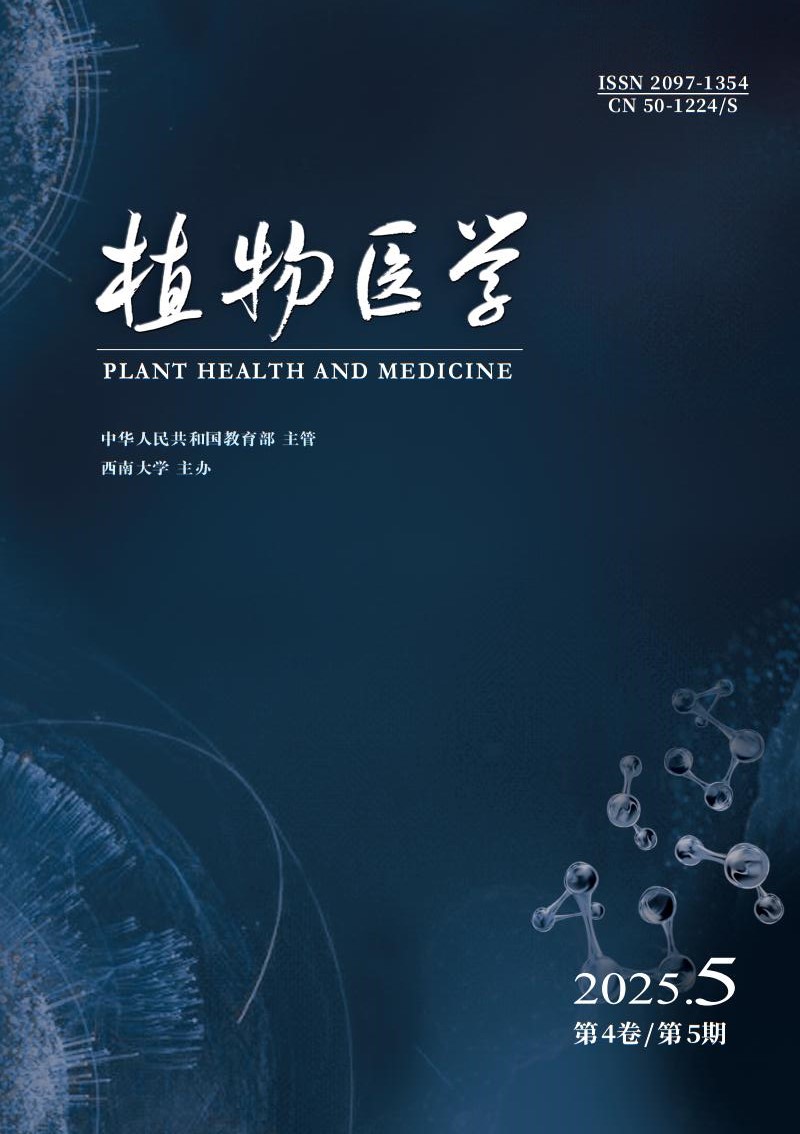-
开放科学(资源服务)标识码(OSID):

-
草果(Amomum tsao-ko Crevost et Lemaire)是姜科(Zingiberaceae)豆蔻属(Amomum)多年生常绿草本植物[1],因其根、茎及果实富含芳香化合物而成为重要的药食同源香料作物. 草果的干果是重要的中药材,常与知母、柴胡、桂皮等配伍. 草果同时是草果饮、柴桂草果汤、草果知母汤、达原饮等汤药,以及透骨搜风丸、宽胸利膈丸、开郁舒肝丸(蒙药)、十一味草果丸(藏药)等中成药的主要成分,主治疟疾寒热、瘟疫发热、脘腹胀痛、痞满呕吐及寒湿内阻等. 草果作为《香辛料和调味品名称》(GB/T 12729.1—2008)中规定的68种常用天然香辛料之一,是五香粉、十三香等大宗调味料的主要成分[2-4]. 草果主要分布于中国云南东南部、广西西部及相邻的越南和老挝北部. 截至2021年,云南省的草果种植面积达14.36万hm2,年产值为19.96亿元,种植面积与产量均占全国90%以上;其中,云南省怒江傈僳自治州、红河哈尼彝族自治州、文山壮族苗族自治州、保山市、德宏傣族景颇族自治州等地为云南草果主要产地,占种植面积的97%[5]. 2013年8月,在云南省红河州屏边苗族自治县大围山国家级自然保护区,发现由小孢拟盘多毛孢(Pestalotiopsis microspora (Speg.) Satista & Peresapud Batista)侵染引起的草果假茎黑斑病,每6.67 hm2草果田间发病率约30%[6]. 近年来,小孢拟盘多毛孢侵染引起的病害呈上升趋势,包括麻风树叶枯病[7]、白术叶枯病[8]、柑橘果斑病[9]、核桃叶枯病[10]、青脆李枯萎病等[11]. 研究温度、光照、pH值、碳源和氮源等对病原菌菌丝生长和产孢的影响,有助于病害的防控[12-14]. 因此,本研究系统探索了草果小孢拟盘多毛孢假茎黑斑病病原菌的生物学特性,以为该病害的田间防治奠定理论基础.
HTML
-
小孢拟盘多毛孢CGJ-3分离自2013年8月在云南省红河州屏边苗族自治县大围山国家级自然保护区(22°58′ N,103°37′ E,海拔1 308 m)的草果假茎黑斑病样品. 试验所需的PDA培养基和改良沙氏葡萄糖蛋白胨琼脂培养基按照杨丽芬等[15]研究中的方法制备.
-
以改良沙氏葡萄糖蛋白胨琼脂培养基为基础,分别以20 g的果糖、麦芽糖、木糖、甘露醇、蔗糖、山梨醇和可溶性淀粉替代葡萄糖配置不同碳源的培养基. 用无菌打孔器取直径6 mm的菌饼接种于不同碳源培养基,每个处理重复3次,在28 ℃恒温暗条件下培养5 d,采用十字交叉法测量菌落直径,15 d后采用血球计数板法测定其产孢量[16].
-
以改良沙氏葡萄糖蛋白胨琼脂培养基为基础,使用10 g的硝酸钠、硝酸铵、硝酸钾、尿素、甘氨酸、牛肉膏、硫酸铵、磷酸铵和甲硫氨酸替代蛋白胨,其他同1.2.1中的操作方法.
-
用无菌打孔器取直径6 mm的菌饼接种于PDA培养基,分别在21,23,25,27,29,31,33,35 ℃条件下进行培养,其他同1.2.1中的操作方法.
-
用无菌打孔器取直径6 mm的菌饼接种至PDA培养基中央,分别培养于全光照、全黑暗、光暗交替(12 h更替)3种条件下,置于28 ℃恒温箱,其余同1.2.1中的操作方法.
-
用0.1 mol/L HCl和0.1 mol/L NaOH溶液将PDA培养基的pH值调至4,5,6,7,8,9,10,11和12,配置9个不同pH值梯度的培养基. 用无菌打孔器取直径6 mm的菌饼接种于PDA培养基中央,在28 ℃恒温箱中暗培养,其他同1.2.1中的操作方法.
-
将直径6 mm的菌饼置于装有5 mL无菌水的试管中,分别放入45~85 ℃的恒温水浴锅中加热10 min,按每5 ℃一个梯度,每个梯度重复3次. 取出后冷却至室温,接种于PDA培养基中央,在28 ℃恒温箱中暗培养,其他同1.2.1中的操作方法.
-
研究数据采用SPSS Statistics 23软件进行统计分析,参考Duncan新复极差法[17]进行多重比较分析,以确定各组之间的显著性差异,p<0.05表示组间差异比较具有统计学意义.
1.1. 试验材料
1.2. 方法
1.2.1. 碳源对菌丝生长及产孢量的影响
1.2.2. 氮源对菌丝生长及产孢量的影响
1.2.3. 温度对菌丝生长及产孢量的影响
1.2.4. 光照对菌丝生长及产孢量的影响
1.2.5. pH值对菌丝生长及产孢量的影响
1.2.6. 病原菌致死温度确定
1.3. 数据处理与统计学分析
-
研究结果显示,小孢拟盘多毛孢CGJ-3在不同碳源中菌丝生长速度与产孢量存在显著差异,所有供试碳源均能支持其生长和产孢,葡萄糖为最适合菌丝生长的碳源,果糖为最佳产孢碳源(表 1).
-
研究结果显示,小孢拟盘多毛孢CGJ-3在不同氮源中菌丝生长速度与产孢量存在显著差异. 除尿素外,所有供试氮源均能支持其生长和产孢,牛肉膏为最佳氮源,而以尿素为氮源的培养基上不产孢(表 2).
-
研究结果显示,小孢拟盘多毛孢CGJ-3适宜生长温度为23~29 ℃,菌落直径均在65.00 mm以上,最适温度为27 ℃,高于30 ℃后菌落直径显著下降,35 ℃停止生长. 适宜产孢温度为25~27 ℃,产孢量均大于等于1.40×106个/mL,最适温度同样为27 ℃,而高于30 ℃则显著抑制其生长和产孢(表 3).
-
研究结果显示,不同光照对小孢拟盘多毛孢CGJ-3的菌丝生长与产孢量有显著影响,完全光照条件下菌丝生长和产孢效果最佳,而在完全黑暗条件下菌丝生长和产孢量显著降低,呈现随光照减弱而降低的趋势(表 4).
-
研究结果显示,pH值对小孢拟盘多毛孢CGJ-3的菌丝生长与产孢量有促进作用,且均呈现先增长后降低的趋势. 该菌在pH值为4~12的培养基上均能生长,适宜生长pH值为4~10,最适pH值为6. 该菌在pH值为4~11时均能产孢,适宜产孢的pH值为5~9,最佳pH值为7(表 5).
-
研究结果显示,经45~60 ℃处理过的小孢拟盘多毛孢CGJ-3菌丝块在转移到新鲜的PDA培养基后5 d仍能生长;经45~55 ℃处理过的菌丝块在转移后能产孢,而经65~75 ℃处理过的菌丝块转移后停止生长,菌丝致死温度为65 ℃(表 6).
2.1. 碳源对小孢拟盘多毛孢菌丝生长及产孢量的影响
2.2. 氮源对小孢拟盘多毛孢菌丝生长及产孢量的影响
2.3. 温度对小孢拟盘多毛孢菌丝生长及产孢量的影响
2.4. 光照对小孢拟盘多毛孢菌丝生长及产孢量的影响
2.5. pH值对小孢拟盘多毛孢菌丝生长及产孢量的影响
2.6. 小孢拟盘多毛孢菌丝致死温度
-
生物学特性研究表明,小孢拟盘多毛孢CGJ-3在不同碳氮源培养基上的菌丝生长与产孢存在显著差异,表明该菌在营养繁殖与生殖繁殖时的营养需求不同,这与前人研究中真菌菌丝生长与产孢、子实体产生时的营养需求存在差异的结论一致[18-19]. 在不同碳源的培养基中,该菌均能生长和产孢,最适碳源为葡萄糖、甘露醇和山梨醇,而木糖表现最差,这与白术叶枯病小孢拟盘多毛孢在以蔗糖、麦芽糖和葡萄糖为碳源的培养基上生长较快的结果不同,也与同为豆蔻属寄主的阳春砂仁上拟盘多毛孢在以麦芽糖、葡萄糖和果糖为碳源的培养基上生长较快的情况不同[20],可能与不同来源的菌株存在差异相关[19]. 以果糖、葡萄糖、蔗糖、甘露醇和淀粉为碳源的培养基上小孢拟盘多毛孢产孢量较高,而以麦芽糖为碳源的培养基上产孢量最低. 小孢拟盘多毛孢菌丝生长与产孢的最适氮源均为牛肉膏和蛋白胨,而尿素效果最差,表明该菌偏好复合型有机氮.
温度对小孢拟盘多毛孢CGJ-3的生长具有显著影响,该菌在23~33 ℃时均能生长,且在23~29 ℃时生长良好. 高于33 ℃则不利于菌丝生长,35 ℃时菌丝停止生长. 23~27 ℃时,菌落直径和产孢量均随温度的升高呈上升趋势,而在29 ℃及以上时,菌落直径和产孢量则随温度的升高而下降. 小孢拟盘多毛孢在23~29 ℃均能产孢,33 ℃及以上则不再产孢,菌丝生长和产孢的最适温度为27 ℃. 本研究结果与白术上小孢拟盘多毛孢的最适温度为25 ℃接近[8],但与砂仁上的拟盘多毛孢最适生长温度为30 ℃不同[20],这可能与草果生长在海拔1 500~2 500 m的林荫下有关.
在不同光照条件下,小孢拟盘多毛孢CGJ-3菌丝生长差异不显著,而孢子产量存在明显差异. 完全光照下的产孢量最多,12 h光照次之,完全黑暗条件下的产孢量最低. 此结果与光照对分离自白术和砂仁的小孢拟盘多毛孢的影响一致[8, 20],但与核桃叶枯病病原菌小孢拟盘多毛孢的情况截然不同[10]. 草果喜阴凉,阳光直晒下,叶片易枯死. 在枯死的叶片上可分离到拟盘多毛孢、镰刀菌和链格孢,这可能是因为拟盘多毛孢容易侵染晒伤的叶片,并大量产孢,从而加速叶片枯死.
在pH值为4~12时,小孢拟盘多毛孢CGJ-3菌丝均能生长,菌落直径和分生孢子产量呈先升高后下降的趋势,菌丝生长的最适pH值为6,产孢的最适pH值为7,这与分离自白术、核桃和砂仁的小孢拟盘多毛孢的最适生长pH值为6相同[8, 10, 20].
报道显示,0.25 μg/mL的咪鲜胺和吡唑醚菌酯能完全抑制柑橘上的小孢拟盘多毛孢,而曹氏甲托和多·锰锌对闽楠叶斑病小孢拟盘多毛孢的菌丝生长和孢子萌发均具有较高的抑制率[21]. 因此,在病害严重时,可采用这4种农药控制草果假茎黑斑病. 从甘草分离的内生细菌抗菌活性评估结果表明,其对草果假茎黑斑病小孢拟盘多毛孢的相对抑菌率均不超过25%[22-23],该病原菌的生防研究仍需进一步的系统研究和田间验证.





 DownLoad:
DownLoad: